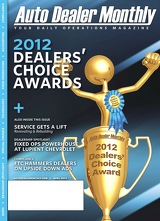Auto Dealer Monthly Magazine is the daily operations publication serving the retail automotive industry. This automotive publication serves dealer principals, officers and general managers with the latest best practices.
Page 15 of 62
industry expert / bhph
mind you get by having the work done by your own staff.
For dealers who choose to sub- let reconditioning and repairs, the obvious advantage is that they don't have the investment in facilities, equipment and staff. The tradeoff is that you have less control over the quality of reconditioning and repairs, and you must rely on the outside shops to get the work done in a timely manner. One of the key factors to success with this option is to develop good relationships with the sublet shops you use and to constantly spot-check the reconditioning and repair estimates that are prepared to ensure that the work being rec- ommended is actually required.
Whichever format you utilize for reconditioning and repairs, the one factor that remains the same for both scenarios is the importance of accurately track- ing and reporting the total cost of the work done. For example, some dealers who have their own mechanic on staff charge the mechanic's hours to staff expense instead of charging the hours to the specific reconditioning or repair order for a specific vehicle. Posting the mechanic's time to a spe- cific work order may take a little longer, but the true cost of reconditioning and repairs needs to include the parts and labor charged to the specific work order. The reason for tracking parts and labor for each specific work order is to accurately report the recondi- tioning expense per vehicle. Monitoring the trends associ- ated with your reconditioning expense can provide valuable insight into the cost of operating your business and the impact on profitability.
Another factor that remains the same for both recondition- ing and repair scenarios is accurately tracking repairs and
expenses after delivery of the vehicle. This expense is most commonly referred to as "policy expense." If policy expense is not tracked and reported accurately, it can produce some shocking results on the profitability of your business. By accurately track- ing repairs and expenses after delivery of the vehicle, you can better gauge the quality and extent of the reconditioning work being done. Under-recon- ditioning or poor-quality reconditioning can result in costly repairs after delivery of the vehicle, and those unexpected costs can produce a negative hit to the bottom line profitability of your BHPH business.
One of my favorite expressions is, "You can't manage what you don't measure!" Accurately tracking and reporting the costs associated with the fixed operations of your BHPH busi- ness will provide valuable infor- mation for managing your business. In the big picture of managing your business, accu- rately tracking and assessing key operational items like rate of return, total expense as a percent of gross profit and operating profit as a percent of sales are just a few of the many key drivers to profitability that successful BHPH dealers measure on a monthly basis.
In summary, as we continue to pay higher prices to buy vehicle inventory, combined with higher mileage on vehicles, we will likely see a correspon- ding increase in the overall cost of reconditioning and repairs on vehicles. Tracking these costs accurately, and managing the impact of these costs on your BHPH business before and after delivery of the vehicle, will become increasingly important to the overall profitability of your BHPH business.
13
